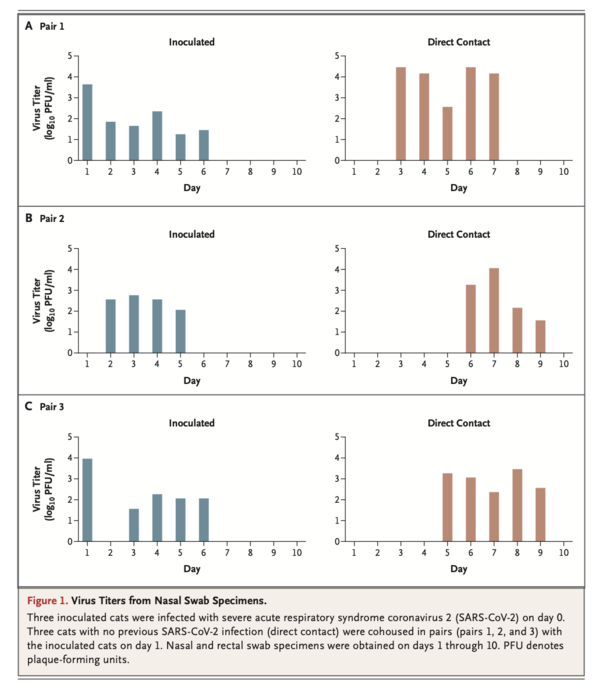Reports of human-to-feline transmission of severe acute respiratory syndrome coronavirus 2 (SARS-CoV-2) and of limited airborne transmission among cats prompted us to evaluate nasal shedding of SARS-CoV-2 from inoculated cats and the subsequent transmission of the virus by direct contact between virus-inoculated cats and cats with no previous infection with the virus. Three domestic cats were inoculated with SARS-CoV-2 on day 0. One day after inoculation, a cat with no previous SARS-CoV-2 infection was cohoused with each of the inoculated cats to assess whether transmission of the virus by direct contact would occur between the cats in each of the three pairs (Table S1). Nasal and rectal swab specimens were obtained daily and immediately assessed for infectious virus on VeroE6/TMPRSS2 cells.
On day 1, we detected virus from two of the inoculated cats. By day 3, virus was detectable in all three inoculated cats, with continued detection of virus until day 5 in all cats and until day 6 in two of the three cats (Figure 1).
The cats with no previous infection were cohoused with the inoculated cats on day 1. Two days later (day 3), one of the cats with no previous infection had infectious virus detected in a nasal swab specimen, and 5 days later, virus was detected in all three cats that were cohoused with the inoculated cats (Figure 1). Virus titers in the cats that were cohoused with the inoculated cats peaked at 4.5 log10 plaque-forming units per milliliter, and virus shedding lasted 4 to 5 days (Figure 1). No virus was detected in any of the rectal swabs tested. Although there have been reports of symptomatic infected cats, none of the cats in our study showed any symptoms, including abnormal body temperature, substantial weight loss (Fig. S1), or conjunctivitis. All the animals had IgG antibody titers between 1:5120 and 1:20,480 on day 24 after the initial inoculation.
With reports of transmission of SARS-CoV-2 from humans to domestic cats and to tigers and lions at the Bronx Zoo, coupled with our data showing the ease of transmission between domestic cats, there is a public health need to recognize and further investigate the potential chain of human-cat-human transmission. This is of particular importance given the potential for SARS-CoV-2 transmission between family members in households with cats while living under "shelter-in-place" orders. In 2016, an H7N2 influenza outbreak in New York City cat shelters highlighted the public health implications of cat-to-human transmission to workers in animal shelters. Moreover, cats may be a silent intermediate host of SARS-CoV-2, because infected cats may not show any appreciable symptoms that might be recognized by their owners. The Centers for Disease Control and Prevention has issued guidelines for pet owners regarding SARS-CoV-2 (www.cdc.gov/coronavirus/2019-ncov/daily-life-coping/animals.html.). Given the need to stop the coronavirus disease 2019 pandemic through various mechanisms, including breaking transmission chains, a better understanding of the role cats may play in the transmission of SARS-CoV-2 to humans is needed.
飼いネコにおけるSARS-CoV-2(新型コロナウィルス)の感染。(N Engl J Med. 2020.05.13)
重症急性呼吸器症候群コロナウイルス2(SARS-CoV-2)のヒトからネコへの感染に関する報告およびネコの間での空気感染は限られているという報告を受けて、ウイルスを接種したネコからのSARS-CoV-2の鼻からの排出と、ウイルスを接種したネコとウイルスに感染したことのないネコとの直接接触によるウイルスのその後の感染を評価した。3匹の家ネコに0日目にSARS-CoV-2を接種した。接種から 1 日後に、SARS-CoV-2 に感染したことのないネコをそれぞれの接種ネコと同居させ、3 組のそれぞれのネコの間で直接接触によるウイルス感染が起こるかどうかを評価した(表 S1)。鼻腔および直腸スワブ検体を毎日採取し、直ちにVeroE6/TMPRSS2細胞上の感染性ウイルスを評価した。
1日目に、接種したネコのうち2匹からウイルスを検出した。3日目までに、接種した3匹のネコすべてからウイルスが検出され、すべてのネコで5日目まで、3匹のネコのうち2匹で6日目までウイルスが検出され続けた(図1)。
感染歴のないネコは1日目に接種したネコと同居させた。2日後(3日目)には未感染ネコのうち1匹が鼻腔内綿棒検体から感染性ウイルスを検出し、5日後には接種ネコと同居していた3匹のネコ全員からウイルスが検出された(図1)。接種ネコと同居していたネコのウイルス力価は4.5 log10 plaque-forming units per milliliterでピークを迎え、ウイルスの排出は4~5日続いた(図1)。検査した直腸スワブからはウイルスは検出されなかった。症状のある感染ネコの報告はあるが、体温の異常、体重の大幅な減少(図S1)、結膜炎などの症状を示したネコはいなかった。すべての動物のIgG抗体価は初回接種後24日目に1:5120~1:20,480であった。
ブロンクス動物園では、SARS-CoV-2のヒトから家ネコ、トラやライオンへの感染が報告されており、家ネコ間での感染が容易であることを示す我々のデータと相まって、公衆衛生上、ヒト-ネコ-ヒト間の感染の連鎖の可能性を認識し、さらに調査する必要性がある。これは、「自宅待機」命令の下で生活している間、ネコのいる家庭の家族間でSARS-CoV-2感染の可能性があることを考えると、特に重要である。2016年にニューヨーク市のキャットシェルターで発生したH7N2インフルエンザのアウトブレイクは、動物シェルターの労働者へのネコから人への感染が公衆衛生に及ぼす影響を浮き彫りにしました。さらに、ネコは、感染したネコが飼い主に認識される可能性のある有意な症状を示さない可能性があるため、SARS-CoV-2のサイレントな中間宿主である可能性があります。疾病対策予防センターは、SARS-CoV-2に関するペットの飼い主のためのガイドラインを発行しています(www.cdc.gov/coronavirus/2019-ncov/daily-life-coping/animals.html)。感染連鎖を断ち切ることを含む様々なメカニズムを通じてコロナウイルス病2019年パンデミックを食い止める必要性を考えると、ネコがSARS-CoV-2のヒトへの感染において果たす可能性のある役割についての理解を深める必要がある。

(Smart119 スタッフコメント)
研究室での実験結果では、ネコーネコ間の感染が容易であることを示されている。ご興味ある方は、原文をご確認ください。またCDCのHPにもペットの飼い主のためのガイドラインが掲載されています(www.cdc.gov/coronavirus/2019-ncov/daily-life-coping/animals.html)
https://www.nejm.org/doi/full/10.1056/NEJMc2013400